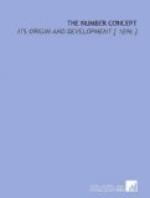In connection with the assertion that the idea of number seems to be understood by the higher orders of animals, the following brief quotation from a paper by Sir John Lubbock may not be out of place: “Leroy ... mentions a case in which a man was anxious to shoot a crow. ’To deceive this suspicious bird, the plan was hit upon of sending two men to the watch house, one of whom passed on, while the other remained; but the crow counted and kept her distance. The next day three went, and again she perceived that only two retired. In fine, it was found necessary to send five or six men to the watch house to put her out in her calculation. The crow, thinking that this number of men had passed by, lost no time in returning.’ From this he inferred that crows could count up to four. Lichtenberg mentions a nightingale which was said to count up to three. Every day he gave it three mealworms, one at a time. When it had finished one it returned for another, but after the third it knew that the feast was over.... There is an amusing and suggestive remark in Mr. Galton’s interesting Narrative of an Explorer in Tropical South Africa. After describing the Demara’s weakness in calculations, he says: ’Once while I watched a Demara floundering hopelessly in a calculation on one side of me, I observed, “Dinah,” my spaniel, equally embarrassed on the other; she was overlooking half a dozen of her new-born puppies, which had been removed two or three times from her, and her anxiety was excessive, as she tried to find out if they were all present, or if any were still missing. She kept puzzling and running her eyes over them backwards and forwards, but could not satisfy herself. She evidently had a vague notion of counting, but the figure was too large for her brain. Taking the two as they stood, dog and Demara, the comparison reflected no great honour on the man....’ According to my bird-nesting recollections, which I have refreshed by more recent experience, if a nest contains four eggs, one may safely be taken; but if two are removed, the bird generally deserts. Here, then, it would seem as if we had some reason for supposing that there is sufficient intelligence to distinguish three from four. An interesting consideration arises with reference to the number of the victims allotted to each cell by the solitary wasps. One species of Ammophila considers one large caterpillar of Noctua segetum enough; one species of Eumenes




